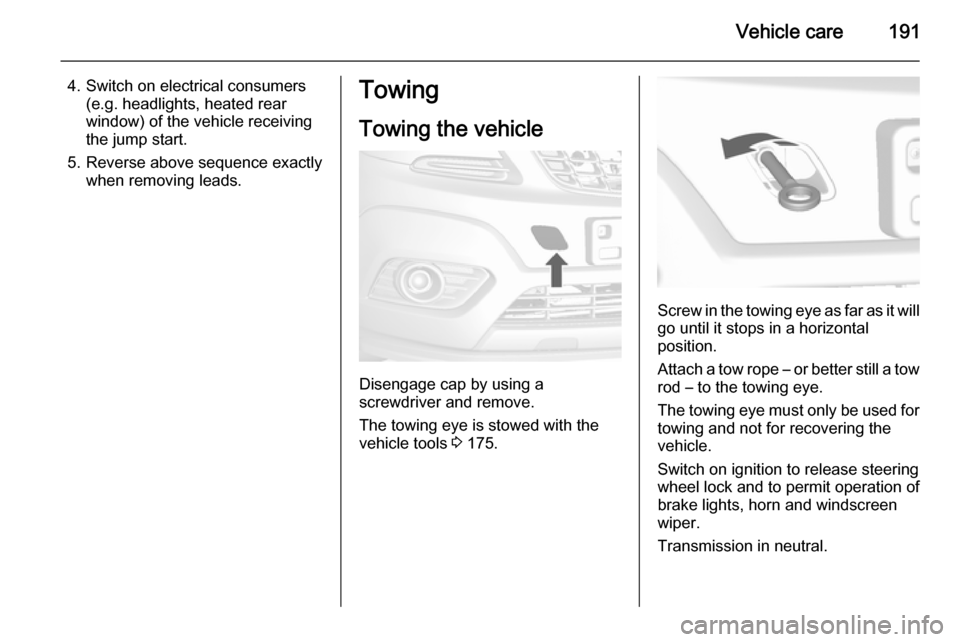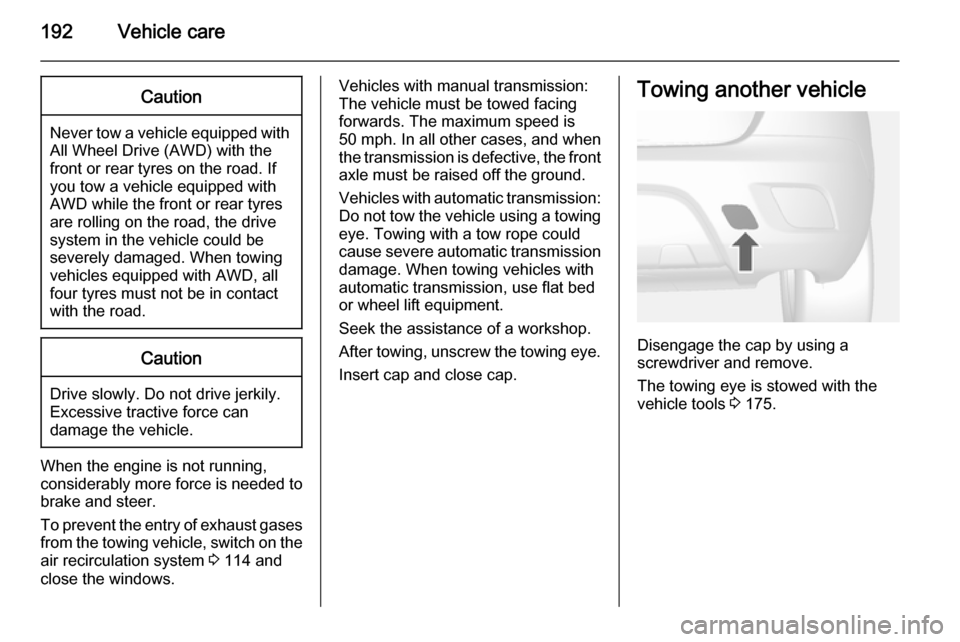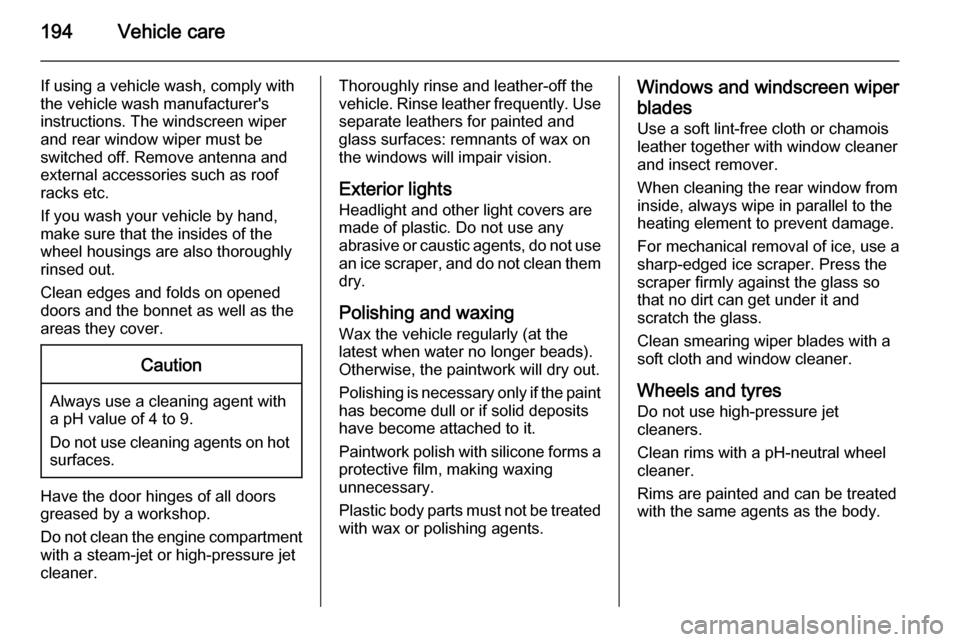wheel VAUXHALL MOKKA 2015 Repair Manual
[x] Cancel search | Manufacturer: VAUXHALL, Model Year: 2015, Model line: MOKKA, Model: VAUXHALL MOKKA 2015Pages: 223, PDF Size: 6.2 MB
Page 193 of 223

Vehicle care191
4. Switch on electrical consumers(e.g. headlights, heated rear
window) of the vehicle receiving
the jump start.
5. Reverse above sequence exactly when removing leads.Towing
Towing the vehicle
Disengage cap by using a
screwdriver and remove.
The towing eye is stowed with the vehicle tools 3 175.
Screw in the towing eye as far as it will
go until it stops in a horizontal
position.
Attach a tow rope – or better still a tow
rod – to the towing eye.
The towing eye must only be used for towing and not for recovering the
vehicle.
Switch on ignition to release steering
wheel lock and to permit operation of
brake lights, horn and windscreen
wiper.
Transmission in neutral.
Page 194 of 223

192Vehicle careCaution
Never tow a vehicle equipped withAll Wheel Drive (AWD) with the
front or rear tyres on the road. If
you tow a vehicle equipped with
AWD while the front or rear tyres
are rolling on the road, the drive
system in the vehicle could be
severely damaged. When towing
vehicles equipped with AWD, all
four tyres must not be in contact
with the road.
Caution
Drive slowly. Do not drive jerkily.
Excessive tractive force can
damage the vehicle.
When the engine is not running,
considerably more force is needed to
brake and steer.
To prevent the entry of exhaust gases from the towing vehicle, switch on the
air recirculation system 3 114 and
close the windows.
Vehicles with manual transmission:
The vehicle must be towed facing
forwards. The maximum speed is
50 mph. In all other cases, and when
the transmission is defective, the front axle must be raised off the ground.
Vehicles with automatic transmission:
Do not tow the vehicle using a towing eye. Towing with a tow rope could
cause severe automatic transmission damage. When towing vehicles with
automatic transmission, use flat bed
or wheel lift equipment.
Seek the assistance of a workshop. After towing, unscrew the towing eye.
Insert cap and close cap.Towing another vehicle
Disengage the cap by using a
screwdriver and remove.
The towing eye is stowed with the
vehicle tools 3 175.
Page 196 of 223

194Vehicle care
If using a vehicle wash, comply with
the vehicle wash manufacturer's
instructions. The windscreen wiper and rear window wiper must be
switched off. Remove antenna and
external accessories such as roof
racks etc.
If you wash your vehicle by hand,
make sure that the insides of the
wheel housings are also thoroughly
rinsed out.
Clean edges and folds on opened
doors and the bonnet as well as the
areas they cover.Caution
Always use a cleaning agent with
a pH value of 4 to 9.
Do not use cleaning agents on hot surfaces.
Have the door hinges of all doors
greased by a workshop.
Do not clean the engine compartment with a steam-jet or high-pressure jet
cleaner.
Thoroughly rinse and leather-off the vehicle. Rinse leather frequently. Use
separate leathers for painted and
glass surfaces: remnants of wax on
the windows will impair vision.
Exterior lights
Headlight and other light covers are
made of plastic. Do not use any
abrasive or caustic agents, do not use an ice scraper, and do not clean them
dry.
Polishing and waxing Wax the vehicle regularly (at the
latest when water no longer beads).
Otherwise, the paintwork will dry out.
Polishing is necessary only if the paint
has become dull or if solid deposits
have become attached to it.
Paintwork polish with silicone forms a
protective film, making waxing
unnecessary.
Plastic body parts must not be treated with wax or polishing agents.Windows and windscreen wiper
blades
Use a soft lint-free cloth or chamois leather together with window cleanerand insect remover.
When cleaning the rear window from
inside, always wipe in parallel to the
heating element to prevent damage.
For mechanical removal of ice, use a
sharp-edged ice scraper. Press the
scraper firmly against the glass so
that no dirt can get under it and
scratch the glass.
Clean smearing wiper blades with a
soft cloth and window cleaner.
Wheels and tyres Do not use high-pressure jet
cleaners.
Clean rims with a pH-neutral wheel
cleaner.
Rims are painted and can be treated
with the same agents as the body.
Page 208 of 223
![VAUXHALL MOKKA 2015 Repair Manual 206Technical dataPerformanceEngineA14NET
B14NET
LPG
A16XERA17DTS
Maximum speed 3)
[mph]Manual transmission120120106118/115 4)Automatic transmission116––1143)
The maximum speed indicated is achiev VAUXHALL MOKKA 2015 Repair Manual 206Technical dataPerformanceEngineA14NET
B14NET
LPG
A16XERA17DTS
Maximum speed 3)
[mph]Manual transmission120120106118/115 4)Automatic transmission116––1143)
The maximum speed indicated is achiev](/img/38/19528/w960_19528-207.png)
206Technical dataPerformanceEngineA14NET
B14NET
LPG
A16XERA17DTS
Maximum speed 3)
[mph]Manual transmission120120106118/115 4)Automatic transmission116––1143)
The maximum speed indicated is achievable at kerb weight (without driver) plus 200 kg payload. Optional equipment could reduce the specified maximum
speed of the vehicle.
4) Vehicles with All-wheel drive system.
Page 209 of 223
![VAUXHALL MOKKA 2015 Repair Manual Technical data207Vehicle weight
Kerb weight, basic model without any optional equipmentEngineManual transmissionAutomatic transmission[kg]A14NET13941409B14NET
LPG1464–A16XER1355–A17DTS14491462A17D VAUXHALL MOKKA 2015 Repair Manual Technical data207Vehicle weight
Kerb weight, basic model without any optional equipmentEngineManual transmissionAutomatic transmission[kg]A14NET13941409B14NET
LPG1464–A16XER1355–A17DTS14491462A17D](/img/38/19528/w960_19528-208.png)
Technical data207Vehicle weight
Kerb weight, basic model without any optional equipmentEngineManual transmissionAutomatic transmission[kg]A14NET13941409B14NET
LPG1464–A16XER1355–A17DTS14491462A17DTS 5)1504–5)
Vehicles with All-wheel drive system.
Optional equipment and accessories increase the kerb weight.
Loading information 3 70.
Vehicle dimensionsLength [mm]4278Width without exterior mirrors [mm]1764Width with two exterior mirrors [mm]2038Height (without antenna) [mm]1658
Page 210 of 223
![VAUXHALL MOKKA 2015 Repair Manual 208Technical data
Length of load compartment floor [mm]729Length of load compartment with folded rear seats [mm]1428Load compartment width [mm]915Load compartment height [mm]757Wheelbase [mm]2555Turni VAUXHALL MOKKA 2015 Repair Manual 208Technical data
Length of load compartment floor [mm]729Length of load compartment with folded rear seats [mm]1428Load compartment width [mm]915Load compartment height [mm]757Wheelbase [mm]2555Turni](/img/38/19528/w960_19528-209.png)
208Technical data
Length of load compartment floor [mm]729Length of load compartment with folded rear seats [mm]1428Load compartment width [mm]915Load compartment height [mm]757Wheelbase [mm]2555Turning circle diameter [m]11.5
Page 212 of 223
![VAUXHALL MOKKA 2015 Repair Manual 210Technical dataTyre pressuresComfort with up to 3 peopleECO with up to 3 peopleWith full loadEngineTyresfrontrearfrontrearfrontrear[kPa/bar]
([psi])[kPa/bar]
([psi])[kPa/bar]
([psi])[kPa/bar]
([psi] VAUXHALL MOKKA 2015 Repair Manual 210Technical dataTyre pressuresComfort with up to 3 peopleECO with up to 3 peopleWith full loadEngineTyresfrontrearfrontrearfrontrear[kPa/bar]
([psi])[kPa/bar]
([psi])[kPa/bar]
([psi])[kPa/bar]
([psi]](/img/38/19528/w960_19528-211.png)
210Technical dataTyre pressuresComfort with up to 3 peopleECO with up to 3 peopleWith full loadEngineTyresfrontrearfrontrearfrontrear[kPa/bar]
([psi])[kPa/bar]
([psi])[kPa/bar]
([psi])[kPa/bar]
([psi])[kPa/bar]
([psi])[kPa/bar]
([psi])A14NET,
B14NET LPG,
A16XER,
A17DTS195/70 R16,200/2.0 (29)200/2.0 (29)270/2.7 (39)280/2.8 (41)270/2.7
(39)280/2.8
(41)205/70 R16215/60 R17,220/2.2 (32)220/2.2 (32)270/2.7 (39)280/2.8 (41)270/2.7
(39)280/2.8
(41)215/65 R16,215/55 R18225/45 R19240/2.4 (35)240/2.4 (35)270/2.7 (39)280/2.8 (41)270/2.7
(39)280/2.8
(41)AllTemporary spare
wheel420/4.2 (61)420/4.2 (61)––420/4.2
(61)420/4.2
(61)
Page 216 of 223

214Customer informationVehicle data recording
and privacy
Event data recorders
Data storage modules in the vehicle
A large number of electronic
components of your vehicle contain
data storage modules temporarily or
permanently storing technical data
about the condition of the vehicle,
events and errors. In general, this
technical information documents the
condition of parts, modules, systems
or the environment:
■ Operating conditions of system components (e.g. filling levels)
■ Status messages of the vehicle and
its single components (e.g. number
of wheel revolutions / rotational
speed, deceleration, lateral
acceleration)
■ Dysfunctions and defects in important system components■ Vehicle reactions in particulardriving situations (e.g. inflation of
an airbag, activation of the stability
regulation system)
■ Environmental conditions (e.g. temperature)
These data are exclusively technical
and help identifying and correcting
errors as well as optimizing vehicle
functions.
Motion profiles indicating travelled
routes cannot be created with these
data.
If services are used (e.g. repair
works, service processes, warranty
cases, quality assurance),
employees of the service network
(manufacturer included) are able to
read out this technical information
from the event and error data storage
modules applying special diagnostic
devices. If required, you will receive
further information at these
workshops. After an error has been
corrected, the data are deleted from
the error storage module or they are
constantly overwritten.When using the vehicle, situations
may occur in which these technical
data related to other information
(accident report, damages on the
vehicle, witness statements etc.) may be associated with a specific person -possibly, with the assistance of an
expert.
Additional functions contractually
agreed upon with the client (e.g.
vehicle location in emergency cases)
allow the transmission of particular vehicle data from the vehicle.
Page 218 of 223

216IndexAAccessories and vehicle modifications .......................... 156
Adaptive forward lighting .....89, 107
Adjustable air vents ...................118
Airbag and belt tensioners ...........84
Airbag deactivation ................46, 84
Airbag label................................... 41 Airbag system .............................. 41
Air conditioning regular operation ................................ 119
Air conditioning system .............. 114
Air intake .................................... 118
Air vents...................................... 118
All-wheel drive ........................... 131
Antilock brake system ................ 131
Antilock brake system (ABS) .......86
Anti-theft alarm system ................25
Anti-theft locking system .............. 25
Appearance care ........................193
Automatic anti-dazzle ..................28
Automatic light control ...............104
Automatic locking ........................23
Automatic transmission .............127
Auxiliary heater ........................... 117
B Battery discharge protection ......112
Battery voltage ............................. 97Bicycle rack .................................. 57
Bonnet ....................................... 158
Bonnet open ................................. 89
Brake and clutch fluid .................198
Brake and clutch system .............85
Brake assist ............................... 133
Brake fluid .................................. 161
Brakes ............................... 131, 161
Breakdown.................................. 191
Bulb replacement ....................... 164
C
Capacities .................................. 209
Catalytic converter .....................126
Central locking system ................21
Centre console storage ...............56
Centre high-mounted brake light 169
Changing tyre and wheel size ...181
Charging system .......................... 85
Child locks ................................... 23
Child restraint installation locations ................................... 49
Child restraints.............................. 47
Child restraint systems ................47
Climate control ............................. 15
Climate control systems .............113
Clock ............................................ 76
Code ............................................. 95
Control indicators.......................... 82
Control of the vehicle .................120
Page 220 of 223

218
Head restraints ............................ 33
Heated mirrors ............................. 28
Heated rear window ..................... 30
Heated steering wheel .................73
Heating ........................................ 37
Heating and ventilation system . 113
High beam ........................... 88, 105
Hill start assist ........................... 133
Horn ....................................... 13, 73
I
Identification plate .....................200
Ignition switch positions .............121
Immobiliser ............................ 26, 88
Indicators ...................................... 79
Information displays...................... 90
Initial drive information.................... 6
Instrument panel fuse box .........172
Instrument panel illumination control .................................... 110
Instrument panel overview ........... 10
Instrument panel storage ..............54
Interior care ............................... 195
Interior lighting ............................ 110
Interior lights ...................... 111, 170
Interior mirrors .............................. 28
Interruption of power supply ......129
Introduction .................................... 3
ISOFIX child restraint systems ....52J
Jump starting ............................. 189
K Key, memorised settings ..............21
Keys ............................................. 19
Keys, locks ................................... 19
L Lane departure warning .......86, 147
Lashing eyes ............................... 69
Lighting features .........................112
Light switch ................................ 104
Load compartment ................24, 66
Load compartment cover .............68
Load compartment fuse box ......174
Loading information .....................70
Low fuel ....................................... 88
M
Malfunction indicator light ............85
Manual anti-dazzle ......................28
Manual mode ............................. 128
Manual transmission .................. 130
Manual windows ..........................29
Memorised settings ......................21
Mirror adjustment ........................... 8
Misted light covers .....................110N
New vehicle running-in ..............121
Number plate light .....................169
O
Object detection systems ...........140
Odometer ..................................... 79
Oil, engine .......................... 198, 202
Operate pedal ............................... 85
Outside temperature ....................76
Overrun cut-off ........................... 122
P Parking ................................ 17, 124
Parking assist ............................ 140
Parking brake ............................ 132
Particulate filter ........................... 125
Performance .............................. 206
Performing work ........................157
Pollen filter ................................. 118
Power outlets ............................... 78
Power steering.............................. 86
Power steering fluid ....................160
Power windows ............................ 29
Preheating ................................... 87
Puncture ..................................... 185